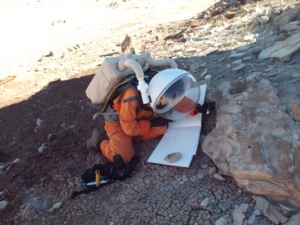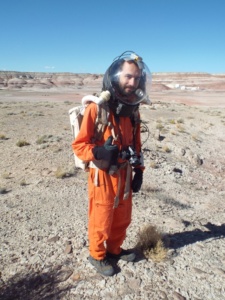EVA Narrative – October 29th
HOW MANY ON AN EVA?
Jon Clarke
Most EVAs in the history of space flight have so far consisted of two people. Some of the earliest EVAs, such as the first EVA of all by Alexi Leonov and the various EVAs carried out during the Gemini program involved only one person outside the spacecraft. A single three-person EVA was performed on Shuttle mission STS-49 to deal with a recalcitrant communications satellite.
The M160 crew are less constrained and we are free to experiment with different numbers and different approaches. So far we have had two, three, and four person EVAs, and four person EVAs comprised of two sub groups.
Today we tried yet another approach. We cycled two EVA teams of two people through the airlock in succession. Each team had different goals and only minimal interaction in the field.
Annalea Beattie sketching lichen colonises on a simulated EVA
The first team visited a previously identified location with a rich lichen community. Annalea drew some of the colonies in the field while Anushree scouted for more lichens and also hypoliths and endoliths.
Alexander wearing his SUIt (Suit User Interface)
The second team visited rock outcrops to record the palaeocurrent directions o each, documented new lichen occurrences and, on an old MDRS suit, tested Aexandre’s Spacesuit User Interface (SSUIt), wearable technology that provides positional and status information for the user while on a simulated EVA.
Examining a cross-bedded sandstone outcrop near the top of a small mesa, a location almost impossible to visit robotically. This location had a wealth of geological information and a diverse lichen community
This approach proved an efficient and effective way of getting multiple tasks done with the available human, space suit, and communications resources. We might try this approach again in the future, especially when we need to achieve multiple tasks in a short time frame.






